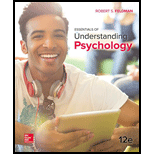
Introduction: A psychological disorder is a clinically significant disturbance that is associated with emotion regulation, behavior, or cognition of an individual. Psychological disorders are usually related to the significant distress in the biological, psychological, or developmental processes repressing the mental functioning. They affect the normal activities of a person on every aspect of life including thoughts, feelings, emotions, behaviors, and outlook.
Answer to Problem 1E
Correct answer: Person K is terrified of elevators. She could be suffering from a phobic disorder. Hence, the correct answer is option (b).
Explanation of Solution
Reason for the correct answers:
Option (b) is given as “phobic disorder”.
A phobic disorder is a type of anxiety disorder that causes a person to feel exaggerate, irrigational fear about a situation, thing, living creature, place, or an activity. As Person K is terrified of elevators, it indicates that Person K is suffering in acrophobia. This is because acrophobia is a type of phobic disorder that is characterize by an extreme or irrigational fear of elevations.
Hence, the correct answer is option (b).
Reasons for the incorrect answers:
Option (a) is given as “obsessive-compulsive disorder”.
Obsessive-compulsive disorder (OCD) is an anxiety disorder characterized by unwanted, uncontrollable and repetitive thoughts, intrusive, and distressing actions. Hence, option (a) is incorrect.
Option (c) is given as “panic disorder”.
A panic disorder is characterized by a feeling of dread, fear, and uncomfortable physical symptoms that reach a peak within minutes. Hence, option (c) is incorrect.
Option (d) is given as “generalized anxiety disorder”.
People with generalized anxiety disorder experience, feel long-term persistent anxiety, fear, and uncontrollable worry. Hence, option (d) is incorrect.
Hence, options (a), (c), and (d) are incorrect.
Person K could be suffering from a phobic disorder.
Want to see more full solutions like this?
Chapter 38 Solutions
Essentials of Understanding Psychology
- In this article what was the advantage an disadvantage of this article and what was the point of the article. https://doi.org/10.1126/science.1182238arrow_forwardIn this article what was the method and what was the results https://doi.org/10.1126/science.1182238arrow_forwardCan you help me find 10 interested discussion topics on evolutionary psychology &culturearrow_forward
- Which of the following are examples of physical maturation influencing cognitive growth? Select all that apply. Physical growth occurs independent of other systems and has little bearing on cognitive processing. As language develops, interaction increases, manipulation of objects including improving fine motor skills, which in turn influences both physical and cognitive abilities. Which of the following are examples of physical maturation influencing cognitive growth? Select all that apply. Physical growth occurs independent of other systems and has little bearing on cognitive processing. As language develops, interaction increases, manipulation of objects including improving fine motor skills, which in turn influences both physical and cognitive abilities. Language acquisition depends on physical development of the brain and vocal cords facilitating learning language and increasing thought processes. Ability to crawl or walk to explore one’s environment increases learning…arrow_forwardWhich statements are true concerning sibling interaction that affects a healthy childhood? Select all that apply. There is no evidence that sibling rivalry and sibling abuse has any long-term effect on children. Some research suggests that one’s personality can be influenced by where you are in the “birth order” of the family. The more children in the home the greater the influence of “birth order” on all the children and future careers. Older siblings can help their younger siblings learn concepts by supporting them during a difficult task, known as scaffolding.arrow_forwardCreativity and intelligence seem to be linked, and recent research appears to support this idea. Including creativity in assessments of intelligence may offer a way to counter issues of test bias. What are your ideas regarding how to educate others and advocate for these changes to be made?arrow_forward
- What page number in the book tangerine is paul asking himself whats wrong with him when he doesnt tell his parents about Erikarrow_forwardWhat page number in the book tangerine by edward bloor is paul is asking himself whats wrong with him when he doesnt tell his parents about erikarrow_forwardI need help finding 20 interesting research peer review articles on evolutionary psychology& culturalarrow_forward
 Ciccarelli: Psychology_5 (5th Edition)PsychologyISBN:9780134477961Author:Saundra K. Ciccarelli, J. Noland WhitePublisher:PEARSON
Ciccarelli: Psychology_5 (5th Edition)PsychologyISBN:9780134477961Author:Saundra K. Ciccarelli, J. Noland WhitePublisher:PEARSON Cognitive PsychologyPsychologyISBN:9781337408271Author:Goldstein, E. Bruce.Publisher:Cengage Learning,
Cognitive PsychologyPsychologyISBN:9781337408271Author:Goldstein, E. Bruce.Publisher:Cengage Learning, Introduction to Psychology: Gateways to Mind and ...PsychologyISBN:9781337565691Author:Dennis Coon, John O. Mitterer, Tanya S. MartiniPublisher:Cengage Learning
Introduction to Psychology: Gateways to Mind and ...PsychologyISBN:9781337565691Author:Dennis Coon, John O. Mitterer, Tanya S. MartiniPublisher:Cengage Learning Psychology in Your Life (Second Edition)PsychologyISBN:9780393265156Author:Sarah Grison, Michael GazzanigaPublisher:W. W. Norton & Company
Psychology in Your Life (Second Edition)PsychologyISBN:9780393265156Author:Sarah Grison, Michael GazzanigaPublisher:W. W. Norton & Company Cognitive Psychology: Connecting Mind, Research a...PsychologyISBN:9781285763880Author:E. Bruce GoldsteinPublisher:Cengage Learning
Cognitive Psychology: Connecting Mind, Research a...PsychologyISBN:9781285763880Author:E. Bruce GoldsteinPublisher:Cengage Learning Theories of Personality (MindTap Course List)PsychologyISBN:9781305652958Author:Duane P. Schultz, Sydney Ellen SchultzPublisher:Cengage Learning
Theories of Personality (MindTap Course List)PsychologyISBN:9781305652958Author:Duane P. Schultz, Sydney Ellen SchultzPublisher:Cengage Learning





